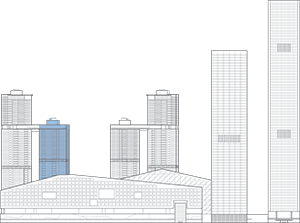Filter by
You must be a CTBUH Member to view this resource.

UpperHills North Tower 1B
SEG-Hitachi Industrial Park Redevelopment Tower 1B
Building
Completed
2015
Residential
All-Concrete
178.9 m / 587 ft
49
2
5
6 m/s
You must be a CTBUH Member to view this resource.
You must be a CTBUH Member to view this resource.
Proposed
Construction Start
Completed
Other Consultant refers to other organizations which provided significant consultation services for a building project (e.g. wind consultants, environmental consultants, fire and life safety consultants, etc).
These are firms that consult on the design of a building's façade. May often be referred to as "Cladding," "Envelope," "Exterior Wall," or "Curtain Wall" Consultant, however, for consistency CTBUH uses the term "Façade Consultant" exclusively.
You must be a CTBUH Member to view this resource.
Usually involved in the front end design, with a "typical" condition being that of a leadership role through either Schematic Design or Design Development, and then a monitoring role through the CD and CA phases.
Usually takes on the balance of the architectural effort not executed by the "Design Architect," typically responsible for the construction documents, conforming to local codes, etc. May often be referred to as "Executive," "Associate," or "Local" Architect, however, for consistency CTBUH uses the term "Architect of Record" exclusively.
The Engineer of Record takes the balance of the engineering effort not executed by the “Design Engineer,” typically responsible for construction documents, conforming to local codes, etc.
The Engineer of Record takes the balance of the engineering effort not executed by the “Design Engineer,” typically responsible for construction documents, conforming to local codes, etc.
The main contractor is the supervisory contractor of all construction work on a project, management of sub-contractors and vendors, etc. May be referred to as "Construction Manager," however, for consistency CTBUH uses the term "Main Contractor" exclusively.
Other Consultant refers to other organizations which provided significant consultation services for a building project (e.g. wind consultants, environmental consultants, fire and life safety consultants, etc).
These are firms that consult on the design of a building's façade. May often be referred to as "Cladding," "Envelope," "Exterior Wall," or "Curtain Wall" Consultant, however, for consistency CTBUH uses the term "Façade Consultant" exclusively.

18 October 2016 | Shenzhen
Yan Meng of Urbanus is interviewed by Chris Bentley during the 2016 CTBUH China Conference. Yan discusses the design process of the Shum Yip Upperhills...

17 October 2016
Jovi Chu, Shum Yip Land Company Limited
Through analysis of dense urban high-rise building complexes as well as research on the relationship of those structures to a city’s social organization, this paper...

18 October 2016 | Shenzhen
Yan Meng of Urbanus is interviewed by Chris Bentley during the 2016 CTBUH China Conference. Yan discusses the design process of the Shum Yip Upperhills...
_©Hufton Crow.jpg)
18 October 2016 | Shenzhen
The issue of skyscraper form and expression being appropriate to cultural and social context is currently a hotly debated topic in China, as well as...

17 October 2016 | Shenzhen
Through analysis of dense urban high-rise building complexes as well as research on the relationship of those structures to a city's social organization, this presentation...
Subscribe below to receive periodic updates from CTBUH on the latest Tall Building and Urban news and CTBUH initiatives, including our monthly newsletter. Fields with a red asterisk (*) next to them are required.
View our privacy policy